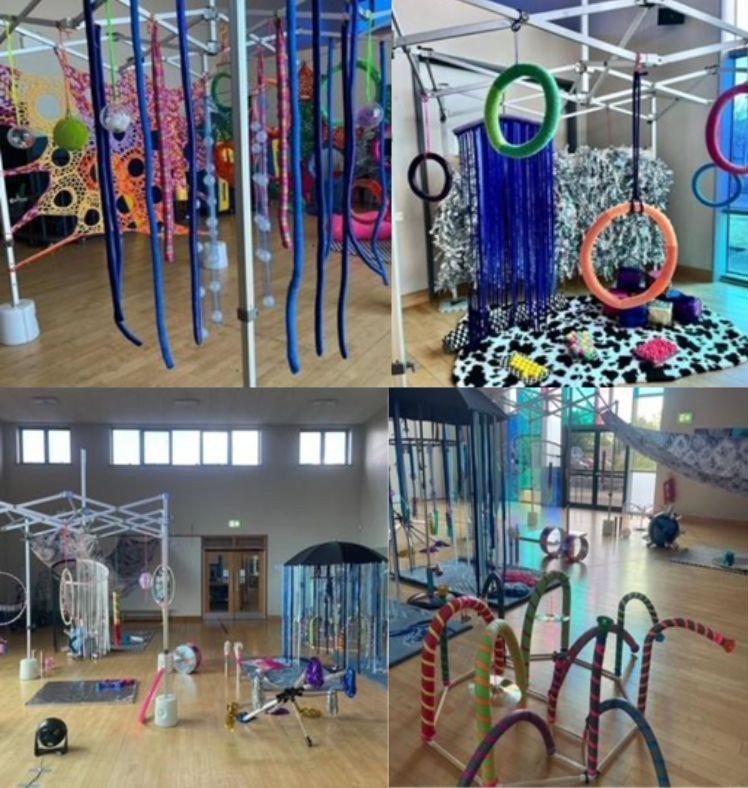Published
2 October 2025
Author
Rachel Wickson reflects on The Play Sculptures Project and how it uses creative, child-led play to support communication, engagement and emotional regulation for children with complex needs.
Communication happens everywhere—and for children with complex needs, the right environment can make all the difference. The Play Sculptures Project is a dynamic, collaborative arts initiative bringing together professionals from health and education, local artists from Make Play (Rachel Sedgwick and Kara Jarold), and local artist Bethany Mitchell to explore the power of play. Led by Lucy Keany and funded by the Arts Council and locality funding, the project has demonstrated how creativity and play support therapy engagement, helping children explore, express, and connect in new ways.
What are Play Sculptures?
Play Sculptures are interactive, child-centred installations, designed to be stimulating yet calming, offering opportunities for movement, exploration, and self-regulation in a safe, structured way. The initial phase of the Play Sculpture project was developed using accessible materials that schools and families could easily replicate. The sculptures include hanging mobiles made from different materials, flexible arch structures, sensory toy stations, and draped materials, including a colourful crochet design. This approach fostered community engagement and hands-on participation. The final phase of the project is currently in development and will feature more durable, permanent sculptures designed for long-term use and public display.

The project was set up at Thomas Wolsey Ormiston Academy in Ipswich, working with all the Early Years and Key Stage 1 classes, who have a wide range of communication needs. In the first phase students had multiple sessions with the local artists, education professionals and speech and language therapy team to assess their needs. The sculptures were then set up for two weeks for the whole school to access and explore. This included 106 students in their class groups, as well as six parent sessions with the education and therapy teams present. The next stage, which has not yet been completed, will allow for six SEN schools and two public sites to explore the final sculptures across the academic year.
Why creative play is therapeutic
We wanted to embrace a flexible and naturalistic approach to communication development, allowing for rich, spontaneous interactions which reflect how children truly connect and express themselves. Each child who interacted with the sculptures engaged meaningfully and made measurable therapeutic progress, tracked through EHCP outcomes and short-term targets. A creative, flexible play space enhanced engagement, emotional safety, and communication development.
“Everything is accessible to my child, which has allowed him to make choices independently.”
– Family feedback
The idea was based on evidence shared from approaches like Attention Autism and The Curiosity Programme which highlight how novelty, sensory stimulation, and shared enjoyment can capture attention and build motivation for meaningful interaction (Davies, 2014; Davies, n.d.). These principles also align with Intensive Interaction (Nind & Hewett, 2006; Hewett, 2007), emphasising attunement and communicative responsiveness, and with Natural Language Acquisition theory, which supports spontaneous speech development through rich, contextual exposure rather than direct prompting (Blanc, 2012).
We also wanted to honour all forms of play. For neurodivergent children, play may involve repetition, sensory exploration, or focused interests – forms of interaction that are deeply communicative and emotionally regulating (Mercer et al., 2022; Kapp et al., 2013). This space allowed for those expressions to flourish fully in a child-led way, recognising them as authentic facets of identity and communication (Bottema-Beutel et al., 2016).
The role of speech and language therapy beyond therapy
From the very beginning, the speech and language therapy team have played an important role in shaping this project. Therapists collaborated closely with the skilled creative team to design interactive play experiences that catered to the diverse communication needs of each child. Therapists actively participated in play sessions, promoting all forms of communication. This included tactile and auditory features,
“It was a great sensory, calming environment.”
– Family feedback
interactive components that responded to movement, and spaces designed to foster social play and shared attention. Recent research supports this approach—naturalistic, child-led therapy leads to measurable improvements in communication, particularly when mediated by parents or peers (Trembath et al., 2024; Rattenbury et al., 2021) Their observations of how children engaged with the sculptures helped refine and inform the development of each element. Therapists used the space to work alongside teachers and families, embedding communication strategies and adapting play to suit individual needs. The result was an environment where every child could express themselves in their preferred way.
Real impact, real voices
The impact has been tangible. The open-ended, child-led nature of the sculptures encouraged increased creativity, engagement, and confidence in communication. Therapists observed a rise in spontaneous communication, increased engagement and shared attention. The sensory and movement-based features support regulation and learning needs.
But the most meaningful reflections came from the children and families themselves. By blending art, therapy, and play, the project has empowered children to explore, express, and connect on their own terms.
What’s next?
The creative team is now developing durable, travel-ready sculptures to share with schools and organisations across Suffolk. As they journey into new settings, their impact will continue to grow—bringing joyful, inclusive, and meaningful communication opportunities to even more children.
References:
- Blanc, M. L. (2012). Natural Language Acquisition on the Autism Spectrum: The Journey from Echolalia to Self-Generated Language. Avocado Press.
- Blanc, R., Leblanc, M., & Allaire, J. (2022). Developmental trajectories following intensive play-based intervention for children with autism. BMC Pediatrics, 22, 173.
- Bottema-Beutel, K., Turiel, E., DeWitt, M. B., & Sandbank, M. (2016). To include or not to include: Evaluations and reasoning about the inclusion of children with autism. Autism, 20(5), 562–574.
- Davies, G. (2014). The Attention Autism Programme: A practical guide to therapy sessions for children with autism and attention difficulties. Gina Davies Autism Centre.
- Davies, G. (n.d.). The Curiosity Programme.
- Hewett, D. (2007). Do we need a specialist approach to teaching communication? The case for Intensive Interaction. British Journal of Special Education, 34(3), 119–124.
- Kapp, S. K., Gillespie-Lynch, K., Sherman, L. E., & Hutman, T. (2013). Deficit, difference, or both? Autism and neurodiversity. Developmental Psychology, 49(1), 59–71.
- Mercer, L., Creighton, J., Holden, J. J. A., & Lewis, M. E. S. (2022). Reframing repetitive behaviors in autism as productive: Focused interests and mastery motivation. Autism in Adulthood, 4(1), 28–38.
- Nind, M., & Hewett, D. (2006). Access to communication: Developing the basics of communication with people with severe learning difficulties through Intensive Interaction. David Fulton Publishers.
- Patterson, J. L., et al. (2019). Pragmatic language gains through peer-mediated, play-based intervention. Journal of Speech, Language, and Hearing Research, 62(10), 3640–3654.
- Prizant, B. M., Wetherby, A. M., Rubin, E., Laurent, A. C., & Rydell, P. J. (2006). The SCERTS Model: A comprehensive educational approach for children with autism spectrum disorders. Paul H. Brookes Publishing.
- Rattenbury, C., et al. (2021). Play-based interventions for communication support in children with neurodevelopmental conditions: A scoping review. Current Developmental Disorders Reports, 8(4), 189–200.
- Trembath, D., Paynter, J., & Keen, D. (2024). Parent-mediated play-based interventions for young autistic children: A meta-analysis. Current Developmental Disorders Reports, 11(2), 155–170.
- Trevarthen, C., & Aitken, K. J. (2001). Infant intersubjectivity: Research, theory, and clinical applications. Journal of Child Psychology and Psychiatry, 42(1), 3–48.
- Wetherby, A. M., & Prizant, B. M. (2000). Autism Spectrum Disorders: A Transactional Developmental Perspective. In A. M. Wetherby & B. M. Prizant (Eds.), Communication and language issues in autism and pervasive developmental disorders (pp. 335–352). Paul H. Brookes Publishing.
 Rachel Wickson
Rachel Wickson


